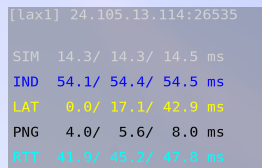Running a Traceroute
We will occasionally request a traceroute to diagnose connection or latency issues. Follow the steps below to perform this test. If you need to check for packet loss, try running a pathping.
Traceroute shows the step-by-step path that a connection takes to its destination.
- Click Start. Windows 8® users start on step 2.
- In the search field, type cmd.
- Right-click on CMD.exe and select Run as Administrator.
- Enter the command tracert xx > c:\tracert.txt and press Enter.
Note: Replace the Xs with the appropriate IP address from the list below. Run this command once per IP address for your region. - Allow several minutes for the traceroute to complete. When you see a new line of text in the command prompt, the traceroute is done. This creates a file on your C: drive called tracert.txt.
Note: If you receive an error, you did not run the command prompt in Administrator Mode. Go back to step three and try again. - Close the command window.
- Go to /Applications/Utilities and start the Terminal application.
- Enter the command traceroute xx > ~/Desktop/tracert.txt
Note: Replace the Xs with the appropriate IP address from the list below. Run this command once per IP address for your region. - Allow several minutes for the traceroute to complete.
- Press Return to create a file on your Desktop called tracert.txt.
- Quit the Terminal application.
Diablo III
| Region | IP Address |
|---|---|
| North America | 24.105.30.129 |
| Brazil (Americas) | 54.94.196.47 |
| Europe | 185.60.112.157 185.60.112.158 |
| Korea | 182.162.135.1 |
| Taiwan | 5.42.161.1 |
| Australia | 103.4.115.248 |
Hearthstone
| Region | IP Address |
|---|---|
| The Americas | 24.105.30.129 |
| Europe | 185.60.112.157 185.60.112.158 |
| Korea and Taiwan | 110.45.208.1 |
Heroes of the Storm
| Region | IP Address |
|---|---|
| North America (Americas) | 24.105.30.129 (US West) 24.105.62.129 (US Central) |
| Australia (Americas) | 103.4.114.233 |
| Singapore (Americas) | 202.9.67.59 |
| Brazil (Americas) | 54.207.104.145 |
| Europe | 185.60.112.157 185.60.112.158 |
| Korea (Asia) | 182.162.116.1 |
| Taiwan (Asia) | 5.42.161.129 |
Overwatch
You can use the in-game Network Graph to find your server's IP address.
- Launch Overwatch and click Play -> Game Browser.
- Use the + Create button to create your own match.
- Click the ADD AI button and click Add.
- Start the game.
- After the map loads, press Ctrl+Shift+N to open the Network Graph.
- The server's IP address is listed in the upper left of the graph.
Note: You need to remove the port and preceding colon (12.345.67.89:PORT) from the IP address before running a test.

If our servers are down, or you are unable to launch the game, use the IPs in this list to run your test.
| Region | IP Address |
|---|---|
| The Americas | 24.105.30.129 (US West) 24.105.62.129 (US Central) |
| Brazil (Americas) | 54.207.107.12 |
| Europe | 185.60.114.159 185.60.112.157 |
| Korea | 211.234.110.1 |
| Taiwan | 5.42.160.129 |
StarCraft II
| Region | IP Address |
|---|---|
| The Americas | 24.105.30.129 (US West) 24.105.62.129 (US Central) |
| Australia (Americas) | 103.4.114.233 |
| Europe | 185.60.112.157 185.60.112.158 185.60.114.159 |
| Korea | 222.231.22.1 |
| Taiwan | 5.42.161.193 |
| Southeast Asia | 202.9.67.254 |
Note: StarCraft II players in the Americas and Europe should test both listed IP Addresses.
World of Warcraft
| Region | IP Address |
|---|---|
| The Americas | 137.221.105.2 (US West) 24.105.62.129 (US Central) |
| Europe | 185.60.112.157 185.60.112.158 185.60.114.159 |
| Korea | 211.115.104.1 |
| Taiwan | 5.42.162.1 |
| Oceania | 103.4.115.248 |
Diablo II and StarCraft
| Region | IP Address |
|---|---|
| North America | uswest.battle.net useast.battle.net |
| Europe | europe.battle.net |
| Asia | asia.battle.net |
Warcraft III
| Region | IP Address |
|---|---|
| North America | 137.221.106.69 137.221.106.169 |
| Europe | 37.244.28.40 37.244.28.140 |
| Asia | 117.52.35.75 117.52.35.175 |
| China | 223.252.226.100 223.252.226.200 |
Diablo II: Resurrected
| Region | IP Address |
|---|---|
| North America | 137.221.106.88 137.221.106.188 |
| Europe | 37.244.28.80 37.244.28.180 |
| Asia | 117.52.35.79 117.52.35.179 |
Diablo Immortal
| Region | IP Address |
|---|---|
| North America | 44.231.167.14 3.136.139.4 |
| South America | 54.232.63.226 |
| Europe | 3.70.139.159 108.128.241.193 |
| Asia | 3.38.60.223 |
| Oceania | 54.153.186.82 |
Diablo IV
| Region | IP Address |
|---|---|
| US Central | 34.170.230.40 |
| US West | 34.105.4.61 |
| Europe | 35.240.124.178 |
| Asia | 34.64.174.8 |
| South America | 35.199.127.159 |
| Australia | 34.116.85.89 |
Before you contact us or post on our forums about connection or latency issues, please have the following information available. This information will help us diagnose issues outside our network.
- Description of the problem, including affected games or services.
- Date and time the issue occured.
- Your IP Address, ISP, and connection type.
- A traceroute and pathping performed when the issue occurs.
- An MTR test performed when the issue occurs.
If you notice any of the following problems in your traceroute report, it may indicate an issue with your connection:
- Time outs
- Asterisk (*) symbols
- Increase in response time between jumps
- Consistently high response times
Safeguards on our servers may cause false latency numbers, or failure with the error message 'Request Timed Out' or 'Destination Net Unreachable'. You can ignore error messages you receive after contacting our servers. To identify our servers, look for the following suffixes: attens.net, att.net, alter.net, telia.net.